Li’s E-Portfolio for CODE 122
Mid Year Check Point:
I’ve just about reached the halfway point of my second semester here at SIUE. I’ve sharpened skills that I’ve previously held while also being mindful of self reflection in order to recognize the areas where improvement is still needed. Of course college isn’t getting any easier but I’ve learned lots of techniques and strategies to better manage my time and increasing workload. I’ve learned how to apply my knowledge across disciplines and also the importance and cruciality of telling a story holistically. Some areas where know I can grow include…..
End of year check point:
End of first year:
As I wrap up my first year of college in a hands-on research program like CODES, I can’t help but feel a whirlwind of emotions. This year has been nothing short of transformative, challenging, and immensely rewarding. As I reflect on my experiences, several key realizations stand out:
Firstly, the hands-on nature of the research program has been invaluable. Unlike traditional classroom learning, where theories are often abstract and disconnected from real-world application, I’ve had the opportunity to dive headfirst into tangible projects. Whether it was conducting interviews,collecting/cleaning data, or analyzing findings, every aspect of my education has been grounded in practical experience. This hands-on approach has not only deepened my understanding of theoretical concepts but has also equipped me with invaluable skills that will serve me well beyond the classroom.
Secondly, I’ve come to appreciate the power of collaboration and mentorship. Throughout the year, I’ve had the privilege of working alongside professors, fellow students, and MOBOT employees who have generously shared their knowledge and expertise. From brainstorming ideas to troubleshooting challenges, the collaborative environment has fostered creativity, critical thinking, and growth. I’ve learned that asking for help is not a sign of weakness but rather a strength, and that the journey of learning is far more enriching when undertaken together.
Furthermore, this year has taught me the importance of resilience and adaptability. Research, by its very nature, is unpredictable, and setbacks are inevitable. Whether it was a survery that didn’t yield the expected results or a project that encountered unforeseen obstacles, I’ve learned to embrace failure as an opportunity for learning and growth. Each setback has taught me resilience, perseverance, and the ability to adapt my approach in the face of adversity.
1.a: Demonstrates ability and commitment to collaboratively work across and within community contexts and structures.
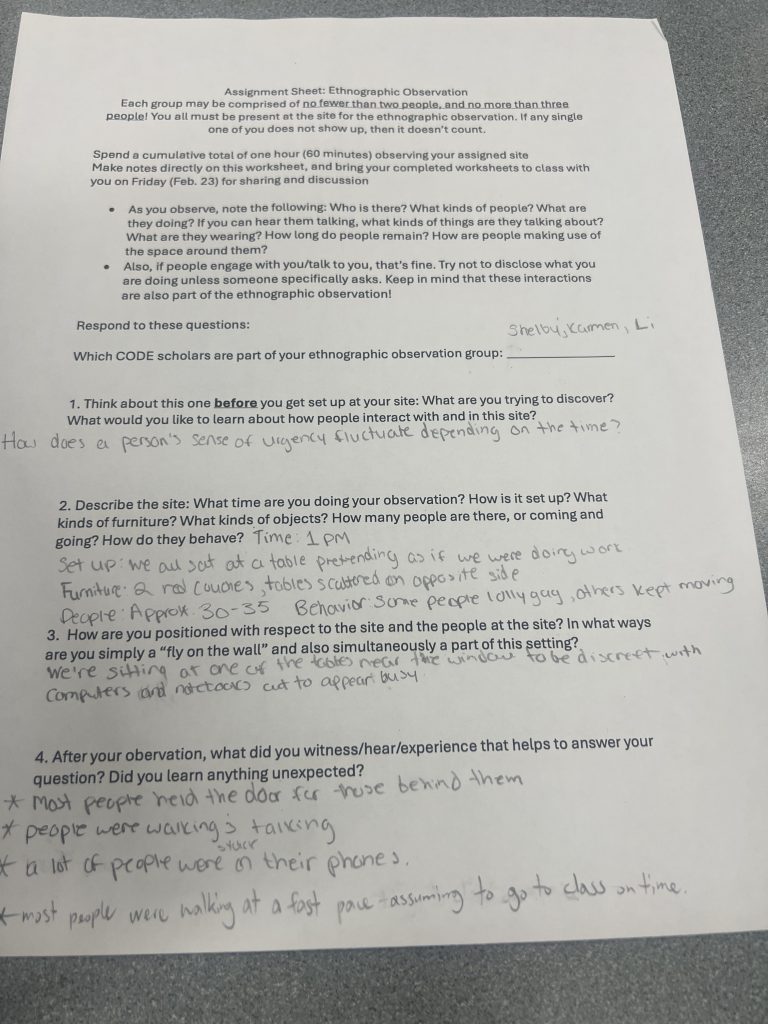
Above are notes from the ethnography that me and fellow cohort members participated in with theme of spatial injustice. We played the roles of silent observers in Peck Hall to answer this question: ” How does sense of urgency fluctuate depending on the time of day?” Although our findings weren’t unusual, it was neat to see what information you could obtain just by sitting in a space and observing. Even the most mundane aspects of college life can be rich with meaning when you take the time to observe and reflect
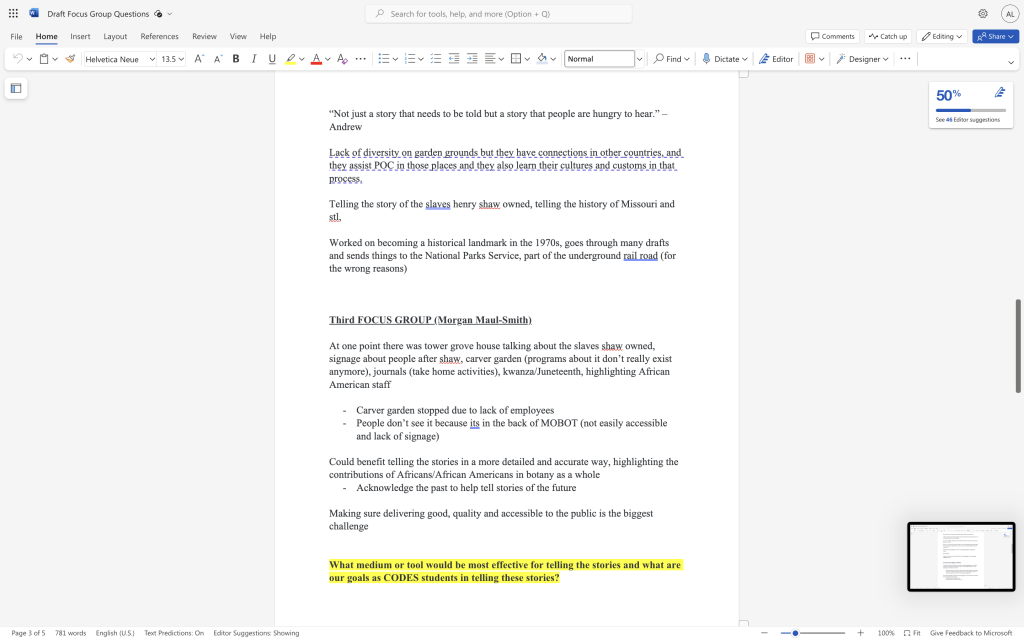
Morgan and John focus group.m4a
Featured above are typed notes and audio recordings from the summation of our focus groups. This was the second step in the process of collecting our data. We noted that a well-executed focus group should “help you understand how a particular trait or identity shapes responses to your research question, see how ideas and opinions are formed and shaped through conversation, and allow participants to collaboratively work through a problem.” All three of these criteria were not just met but exceeded. I found that the focus groups were a lot more informative, honest, and in-depth compared to the surveys. I feel like this was because they had no other choice but to sit down and think of a response whereas with a survey you can just exit out of it. There is a fresher, more intense version of accountability imposed onto the participants in a focus group setting which produced more authentic answers.
D
Included above is our completed final project for CODES 122. The creation of this video required immense amounts of patience, trial and error, and coordination on all of our behalves. It synthesizes all that we have learned and presents it in a format that is tech savvy and easy to understand. I did a lot of the video editing and visualization collection here.
3.b: Recognizes multilayered ethical issues and the cross-relationships among them.
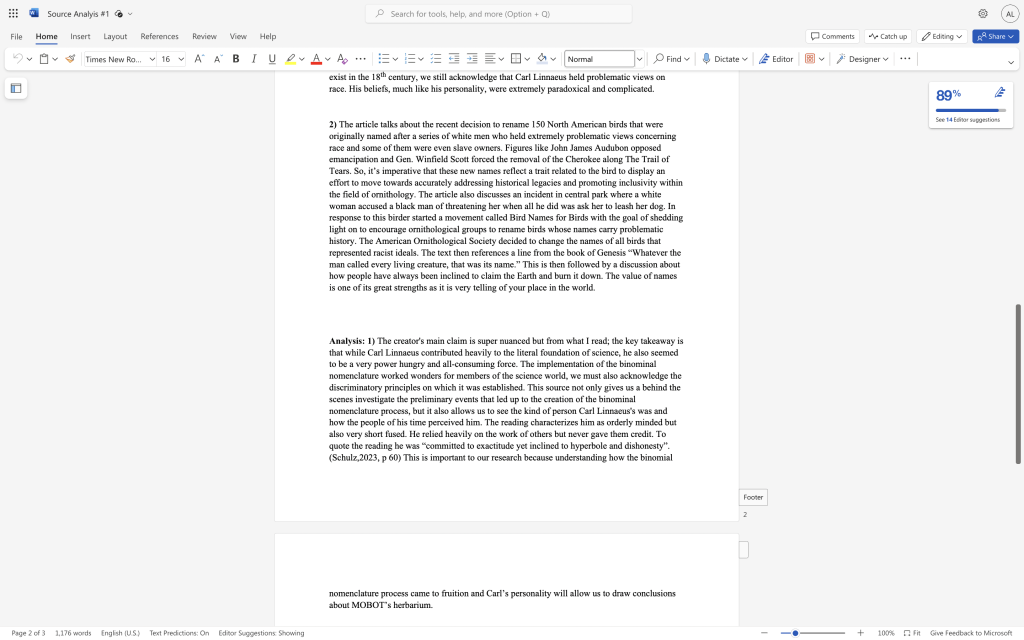
This is a section from source analysis # 1 where went over two articles. One that discussed Carl Linneaus’ history and one about the renaming of 150 bird species. I connected the history of Carl Linnaeus to the work we do in CODES because understanding how the binomial nomenclature process came to fruition and Carl’s personality will allow us to draw conclusions about MOBOT’s herbarium. The renaming of the bird species ties into our research because we are trying to tell the story of the folks who have not been accounted for and the ornithological community is trying to highlight aspects of history concerning bird naming that isn’t frequently discussed. It shows us that although the work we’re doing is difficult it is possible to reach that goal.
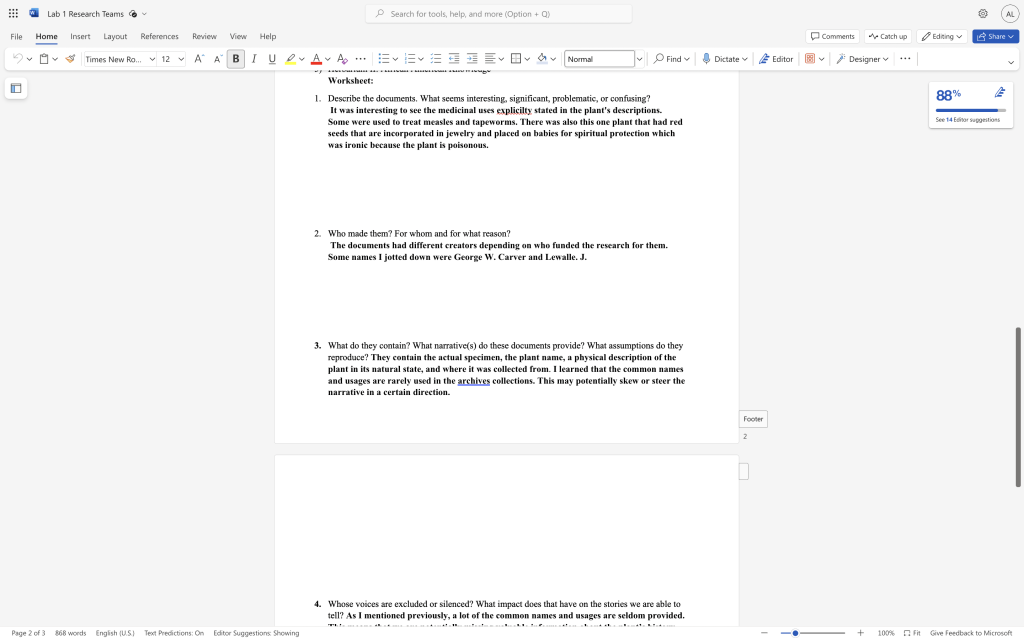
Above is a screenshot from the completion of lab assignment #1. At MOBOT, we examined the plant specimens from the archives presented to us with each of our research team’s themes in mind. After analyzing the documents we noticed that the medicinal uses were explicilty stated in the plant’s descriptions. Some were used to treat measles and tapeworms. There was also this one plant that had red seeds that are incorporated in jewelry and placed on babies for spiritual protection which was ironic because the plant is poisonous. Getting to interact with the specimens up close and personal knowing that they were catered to our specific research goals was a very unique person.

This is a summary I provided after reading assigned articles for source analysis #2. We were instructed to think about how climate change is impacting the plants and people in the Himalayas. By analyzing this example of ethnobotany I learned that we should look at our wicked problem holistically by looking at the direct and indirect drivers that comprise the issue. For the issue of inequality in botany some direct drivers might be white supremacy & oppression of POC. Some indirect drivers might be the intentional absence of POC at the table when it is time to decide who gets to plant what. There is also an intentional absence of instruction for POC about the plant industry in general. We should look at drivers that are not just specific to the local context but also what is contributing to it globally.
5.a: Defines the scope of research questions effectively and selects information cogently to address them.
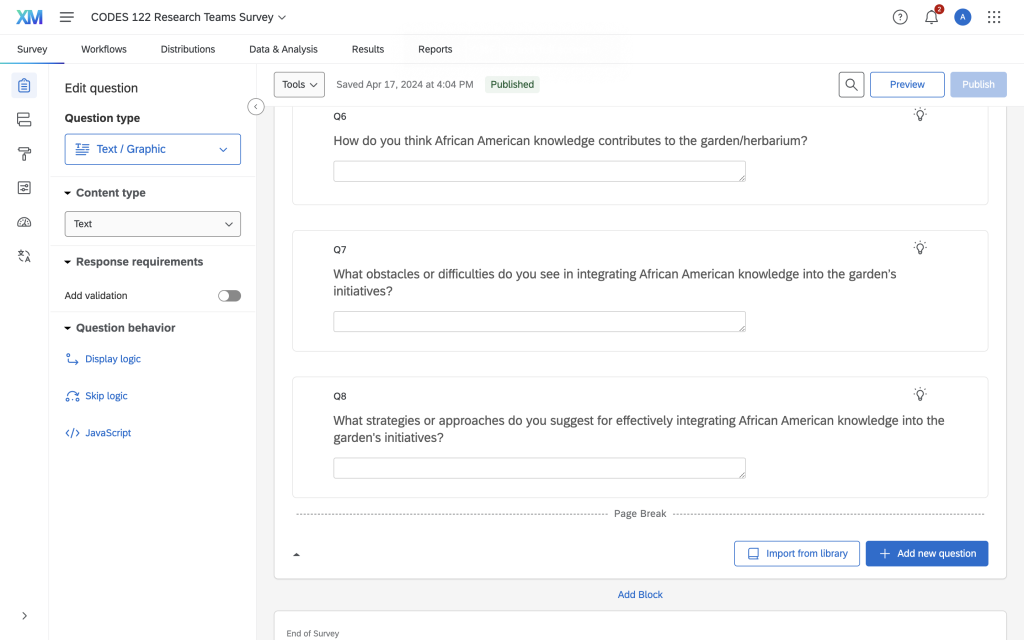
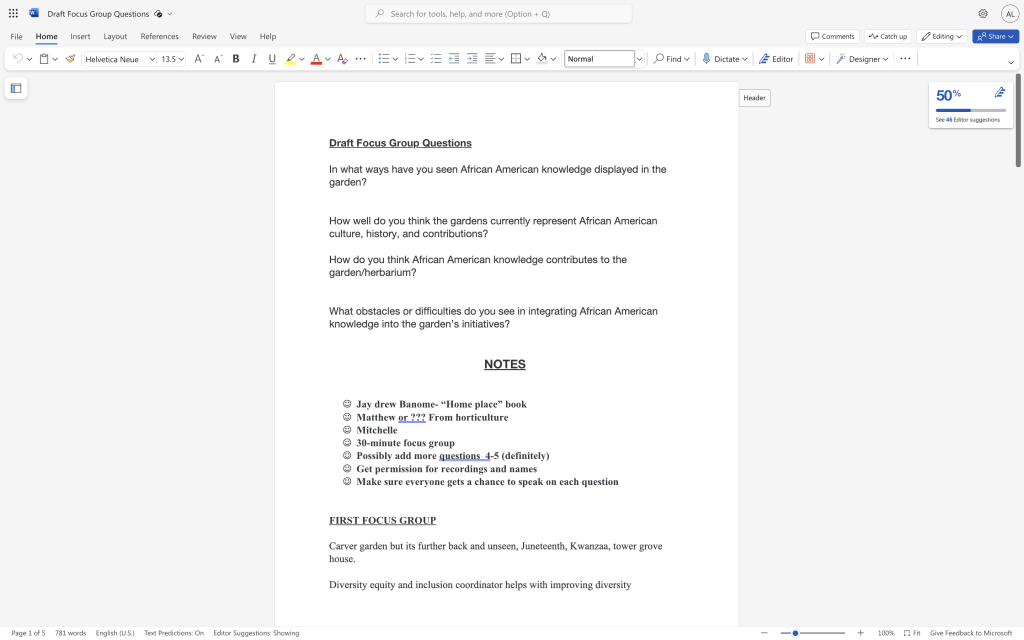
Pictured above is a section of my group’s final survey questions as well as our draft questions. The creation of our surveys was a very iterative process requiring great amounts of patience and meticulous refining. Gathering thoughtful and thorough answers from our survey’s participants proved to be quite challenging but we got it done. The overarching goal of the survey questions was to gain an understanding of how the current employees at MOBOT perceive the lack of African American representation and knowledge within the herbarium. These questions helped us to gain insight into the ” mind of MOBOT”
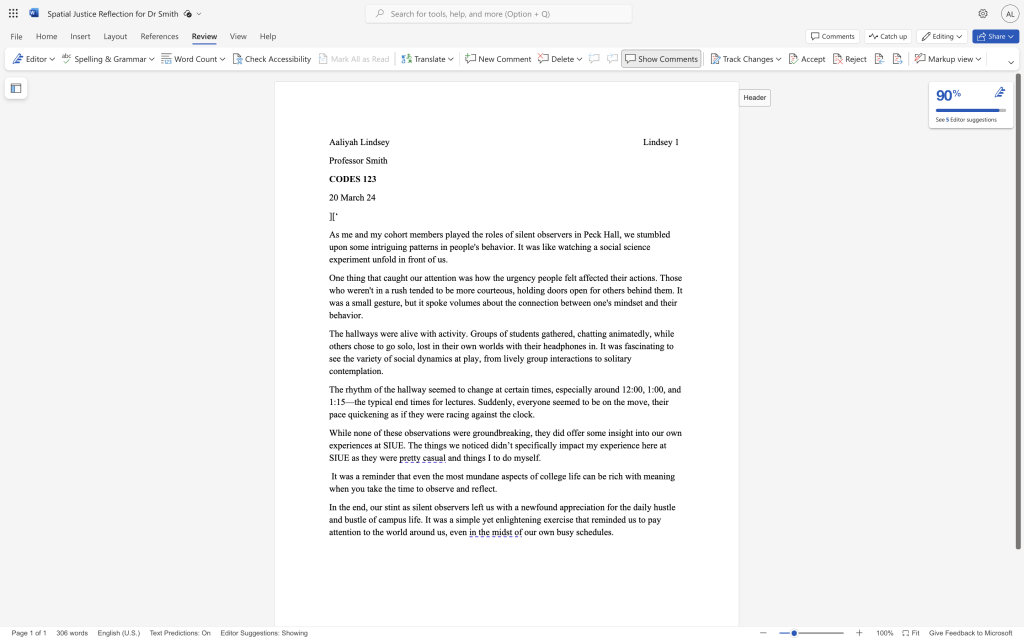
Pictured above is the completion of my spatial justice analysis reflection. Me and my cohort members played the roles of silent observers in Peck Hall to answer this question: ” How does sense of urgency fluctuate depending on the time of day?” Although our findings weren’t unusual, it was neat to see what information you could obtain just by sitting in a space and observing. Even the most mundane aspects of college life can be rich with meaning when you take the time to observe and reflect
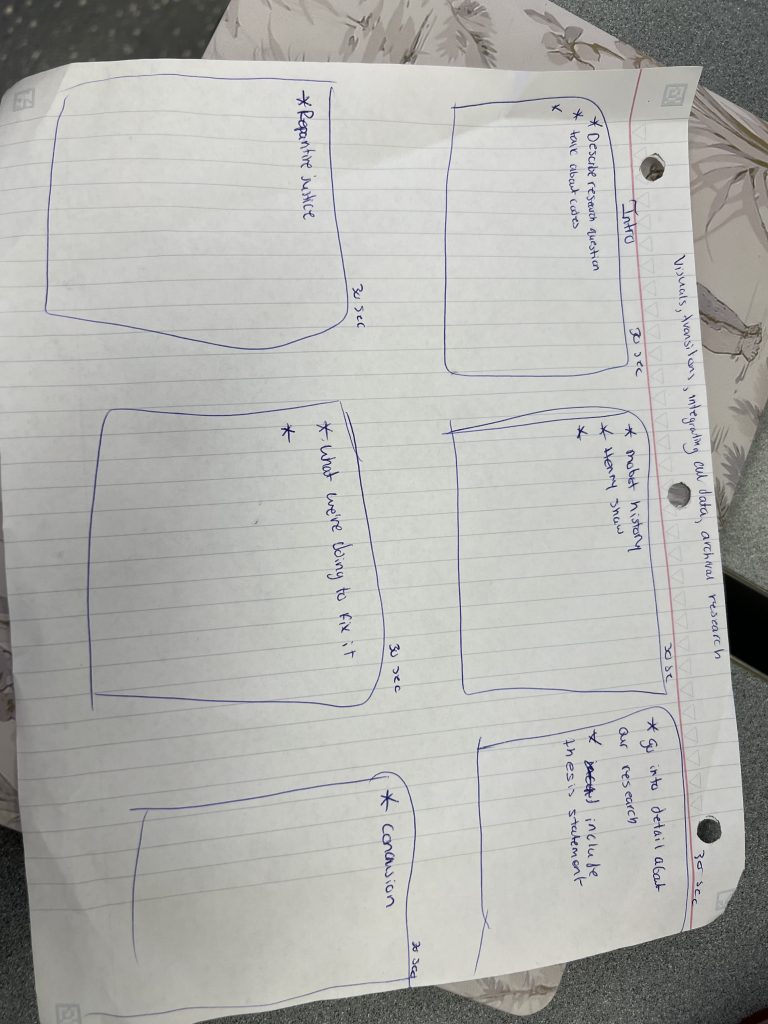
While this image is a bit rough around the edges, it demonstrates the beginning phases of storyboarding for our final project. These 6 boxes led to the synthesizing of an entire works semester which was a highly meticulous process. Each box represents a 30 second chunk of the video containing key points and takeaways.
9.a: Constructs insightful problem statements with evidence of relevant factors.
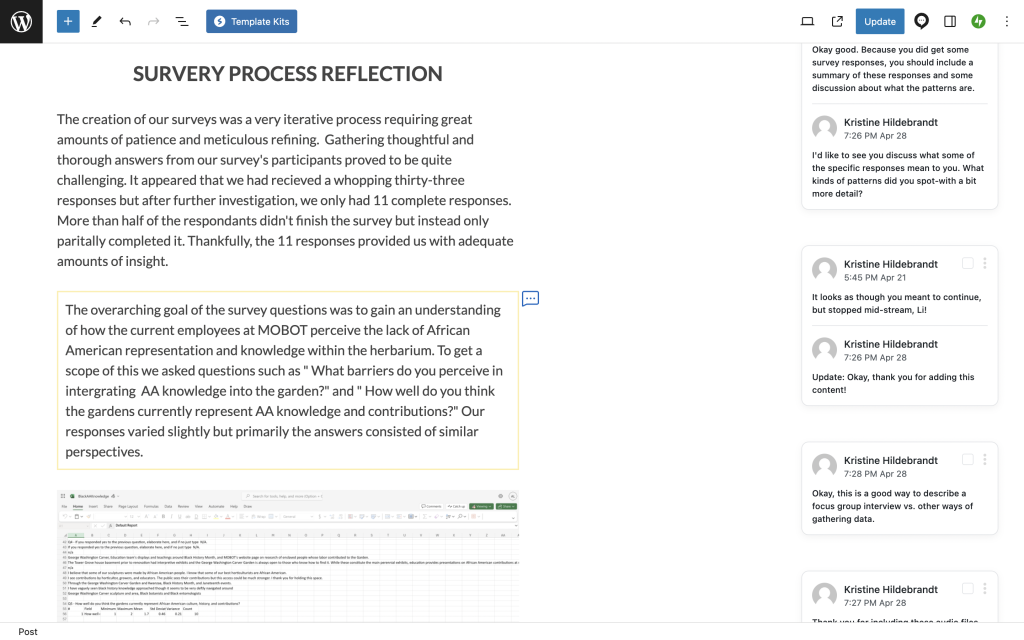
(
The creation of our surveys was a very iterative process requiring great amounts of patience and meticulous refining. Gathering thoughtful and thorough answers from our survey’s participants proved to be quite challenging.The overarching goal of the survey questions was to gain an understanding of how the current employees at MOBOT perceive the lack of African American representation and knowledge within the herbarium. To get a scope of this we asked questions such as ” What barriers do you perceive in intergrating AA knowledge into the garden?” and ” How well do you think the gardens currently represent AA knowledge and contributions?” Our responses varied slightly but primarily the answers consisted of similar perspectives.

Pictured above is a portion of source analyis #3. We were instructed to analyze an article that discusses the historical connection between botanical knowledge and slavery, with an emphasis on how enslaved indiviudals contributions often go unnoticed.
11.a: Evaluates texts’ scholarly significance to apply reading to other contexts or issues
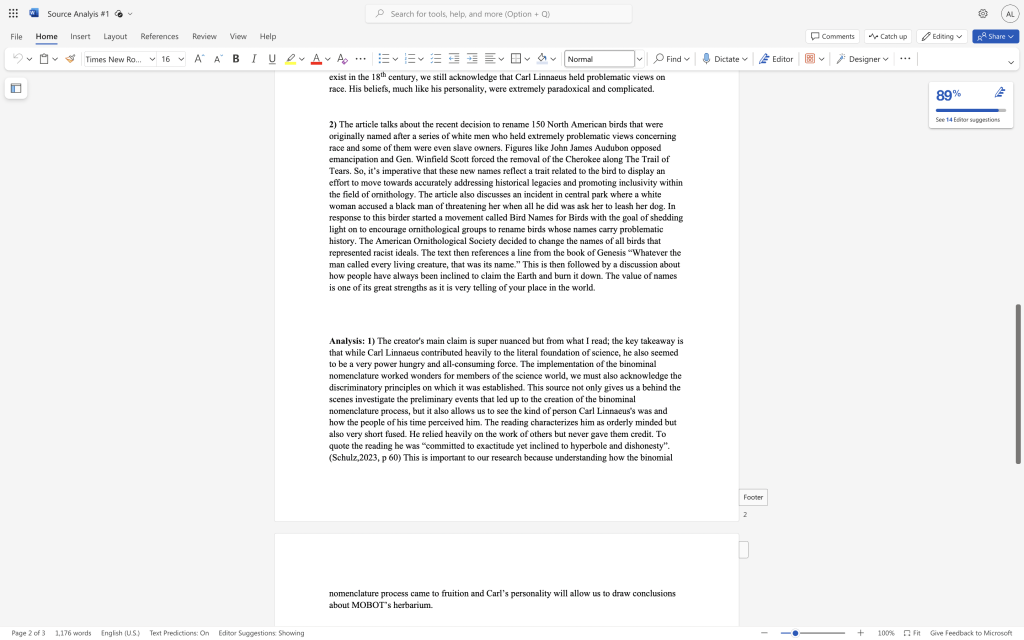
This is a section from source analysis # 1 where went over two articles. One that discussed Carl Linneaus’ history and one about the renaming of 150 bird species. I connected the history of Carl Linnaeus to the work we do in CODES because understanding how the binomial nomenclature process came to fruition and Carl’s personality will allow us to draw conclusions about MOBOT’s herbarium. The renaming of the bird species ties into our research because we are trying to tell the story of the folks who have not been accounted for and the ornithological community is trying to highlight aspects of history concerning bird naming that isn’t frequently discussed. It shows us that although the work we’re doing is difficult it is possible to reach that goal.
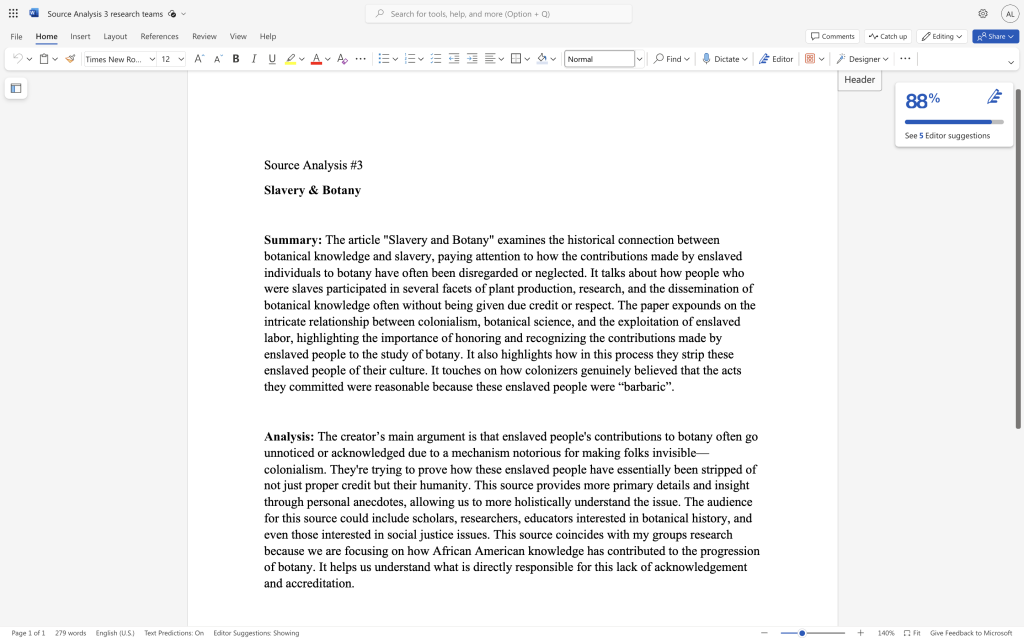
Pictured above is a portion of source analyis #3. We were instructed to analyze an article that discusses the historical connection between botanical knowledge and slavery, with an emphasis on how enslaved indiviudals contributions often go unnoticed.
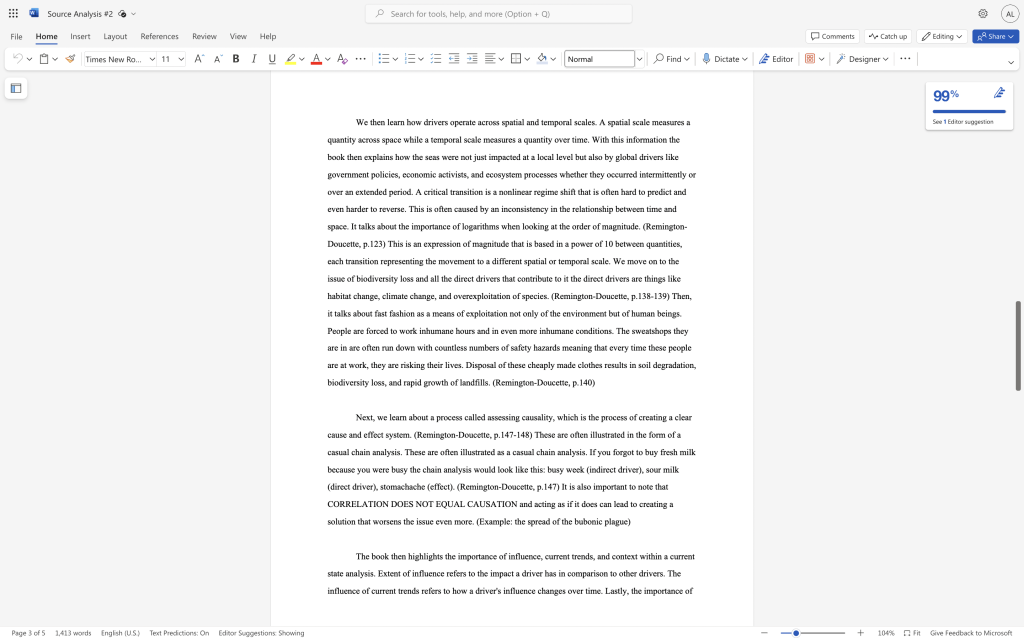
This is a summary I provided after reading assigned articles for source analysis #2. We were instructed to think about how climate change is impacting the plants and people in the Himalayas. By analyzing this example of ethnobotany I learned that we should look at our wicked problem holistically by looking at the direct and indirect drivers that comprise the issue. For the issue of inequality in botany some direct drivers might be white supremacy & oppression of POC. Some indirect drivers might be the intentional absence of POC at the table when it is time to decide who gets to plant what. There is also an intentional absence of instruction for POC about the plant industry in general. We should look at drivers that are not just specific to the local context but also what is contributing to it globally.